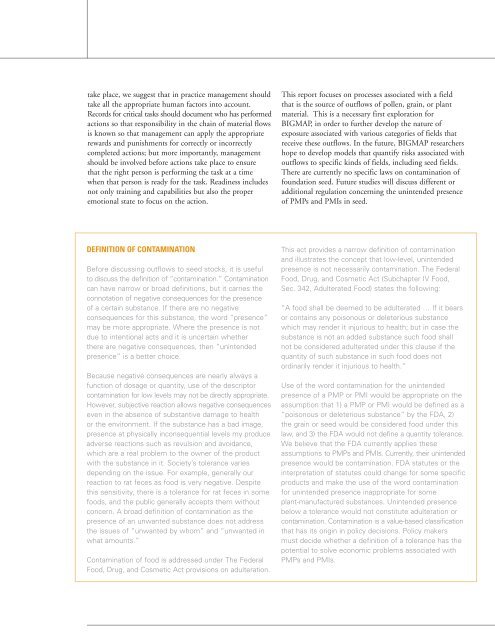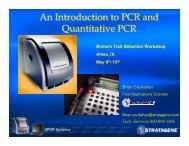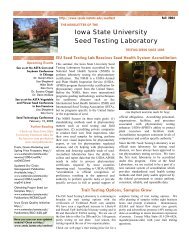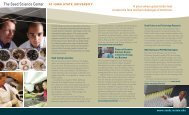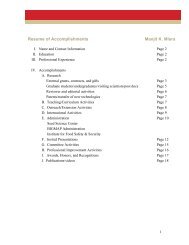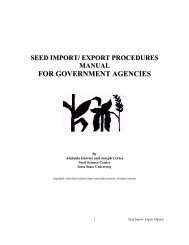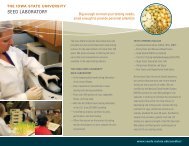take place, we suggest that in practice management shouldtake all the appropriate human factors into account.Records <strong>for</strong> critical tasks should document who has per<strong>for</strong>medactions so that responsibility in the chain of material flowsis known so that management can apply the appropriaterewards and punishments <strong>for</strong> correctly or incorrectlycompleted actions; but more importantly, managementshould be involved be<strong>for</strong>e actions take place to ensurethat the right person is per<strong>for</strong>ming the task at a timewhen that person is ready <strong>for</strong> the task. Readiness includesnot only training and capabilities but also the properemotional state to focus on the action.This report focuses on processes associated with a fieldthat is the source of outflows of pollen, grain, or plantmaterial. This is a necessary first exploration <strong>for</strong>BIGMAP, in order to further develop the nature ofexposure associated with various categories of fields thatreceive these outflows. In the future, BIGMAP researchershope to develop models that quantify risks associated withoutflows to specific kinds of fields, including seed fields.There are currently no specific laws on contamination offoundation seed. Future studies will discuss different oradditional regulation concerning the unintended presenceof PMPs and PMIs in seed.DEFINITION OF CONTAMINATIONBe<strong>for</strong>e discussing outflows to seed stocks, it is usefulto discuss the definition of “contamination.” Contaminationcan have narrow or broad definitions, but it carries theconnotation of negative consequences <strong>for</strong> the presenceof a certain substance. If there are no negativeconsequences <strong>for</strong> this substance, the word “presence”may be more appropriate. Where the presence is notdue to intentional acts and it is uncertain whetherthere are negative consequences, then “unintendedpresence” is a better choice.Because negative consequences are nearly always afunction of dosage or quantity, use of the descriptorcontamination <strong>for</strong> low levels may not be directly appropriate.However, subjective reaction allows negative consequenceseven in the absence of substantive damage to healthor the environment. If the substance has a bad image,presence at physically inconsequential levels my produceadverse reactions such as revulsion and avoidance,which are a real problem to the owner of the productwith the substance in it. Society’s tolerance variesdepending on the issue. For example, generally ourreaction to rat feces as food is very negative. Despitethis sensitivity, there is a tolerance <strong>for</strong> rat feces in somefoods, and the public generally accepts them withoutconcern. A broad definition of contamination as thepresence of an unwanted substance does not addressthe issues of “unwanted by whom” and “unwanted inwhat amounts.”Contamination of food is addressed under The Federal<strong>Food</strong>, Drug, and Cosmetic Act provisions on adulteration.This act provides a narrow definition of contaminationand illustrates the concept that low-level, unintendedpresence is not necessarily contamination. The Federal<strong>Food</strong>, Drug, and Cosmetic Act (Subchapter IV <strong>Food</strong>,Sec. 342, Adulterated <strong>Food</strong>) states the following:“A food shall be deemed to be adulterated … If it bearsor contains any poisonous or deleterious substancewhich may render it injurious to health; but in case thesubstance is not an added substance such food shallnot be considered adulterated under this clause if thequantity of such substance in such food does notordinarily render it injurious to health.”Use of the word contamination <strong>for</strong> the unintendedpresence of a PMP or PMI would be appropriate on theassumption that 1) a PMP or PMI would be defined as a“poisonous or deleterious substance” by the FDA, 2)the grain or seed would be considered food under thislaw, and 3) the FDA would not define a quantity tolerance.We believe that the FDA currently applies theseassumptions to PMPs and PMIs. Currently, their unintendedpresence would be contamination. FDA statutes or theinterpretation of statutes could change <strong>for</strong> some specificproducts and make the use of the word contamination<strong>for</strong> unintended presence inappropriate <strong>for</strong> someplant-manufactured substances. Unintended presencebelow a tolerance would not constitute adulteration orcontamination. Contamination is a value-based classificationthat has its origin in policy decisions. Policy makersmust decide whether a definition of a tolerance has thepotential to solve economic problems associated withPMPs and PMIs.
OUTFLOWS TO SEED STOCKSThe management of confinement to high levels ofstringency with respect to foundation and research seedis of special importance. Unintended presence inresearch and foundation seed stocks has the potential tospread a trait more widely and to avoid dilution thatwould normally occur as grain passes through the bulkgrain handling system. The StarLink incident showedthat the most potentially serious kind of PMP or PMIconfinement failure is one that would result in unintendedpresence in commercial, foundation, or research seedstocks (http://www.starlinkcorn.com/starlinkcorn.htm).The regulations that governed its presence in foodestablished a zero tolerance. The StarLink failure hadeconomic implications but posed no concerns <strong>for</strong> humanor animal health and safety. This example demonstratesthat the economic consequences of confinement failureas well as risk to health and the environment per se areimportant concerns <strong>for</strong> the success of PMP and PMItechnology. The StarLink incident made low-leveltolerances look “attractive” to seed and grain producers.Isolation standards used within the seed industry includeprovision <strong>for</strong> minimum isolation from corn foundationproduction and corn research nurseries and provisions<strong>for</strong> verification that all such fields are known to the PMPand PMI producer. These standards explicitly state thelevels of seed purity they are meant to achieve. Undermost circumstances, they provide and upper limit to theconcentration of a PMP that could be present in seed.Because it is useful to separate the exposure associatedwith outflows into corn grain production fields from outflowsinto commercial and foundation seed productionfields, it also is useful to differentiate outflows thatcould result in the unintended presence of PMPs orPMIs in commercial and foundation seed from thosethat could result in unintended presence in breeder’sseed. Breeder’s seed is very pure seed produced underresearch conditions by self-pollination (selfing). It is usedas the source of foundation seed. In commercial seedsystems, all foundation stocks are restarted periodicallyfrom breeder’s seed. Foundation corn seed is normallylimited to three generations from breeder seed. 2Unintended presence in commercial and foundationseed can be spread to fields planted with the seed orseed produced from it, but spread from these sources isself-limiting, and the level of unintended presenceremains at about the level created when the contaminationoccurred. Unintended presence is eliminated when thestocks are restarted from breeder’s seed. Unintendedpresence in research and breeder’s seed could beself-perpetuating in some circumstances, and there is,in theory, no upper limit on the level of presence. Thispotential <strong>for</strong> a low-level tolerance in grain to lead to high-levelunintended presence in seed makes tolerance substantiallyless attractive <strong>for</strong> PMPs and PMIs and provides anargument <strong>for</strong> the use of a broader definition of contaminationwhen discussing PMPs and PMIs.SYSTEM DESCRIPTIONThis report consists of 1) a description of key rationalebehind design of the good practices; 2) flowcharts thatschematically illustrate how the good practices occur asintegrated sequences of management activities that haveimplications to materials fate in the PMP or PMI cornproduction system; and 3) a hierarchical outline of majorprocesses, subprocesses, and actions that have a bearing onmaterial flows (i.e., the fate of corn seed, grain, pollen,and plant residue) occurring in the production system.We have approached the processes involved in the productionof PMPs and PMIs in the way that these processes wouldbe approached <strong>for</strong> an exercise in process management. In abusiness situation, process management wouldbe used to manage cost and productivity, identifyimprovement opportunities, reduce employee stress,and leverage opportunities. In this report, we are mainlyconcerned with regulatory compliance and minimizingthe probability and negative consequences associated withfailure of confinement. Our focus differs from that of abusiness in two ways. First, a business would have a broaderview of optimizing their production system, going beyondregulatory needs to encompass all aspects of productdevelopment and commercial production. Second, weare concerned with monitoring outflows of material andthere<strong>for</strong>e make inflows and outflows of materials andresources a more explicit part of the model than woulda business process management exercise.2 There is no regulatory generation limit <strong>for</strong> corn foundation seed in most states. Washington limits foundation increases to 2 generations and is, in recent years, producing asignificant portion of the US foundation seed. The normal limit of 3 generations in industry practice is based on the combination of lack of need <strong>for</strong> more than 3 generationsin corn and the accumulated empirical experience in industry of incremental accumulation of impurities. With 3 generations of foundation increase, using conservative multiplicationfactors, 10 kg of breeder’s seed <strong>for</strong> a line used as a female can be increased to enough seed to foundation seed to grow hybrid seed <strong>for</strong> 37,000,000 ha, more thanthe area of the entire US corn crop.Introduction 11


